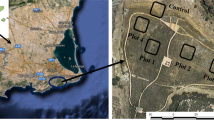Abstract
Remediation of the technogenic barrens around the Pechenganikel works on the Kola Peninsula resulted in the improvement of the soil properties, namely, in a decrease in acidity and enrichment with nutrients, which continued for several years. However, the reaction of most of the treated soils remained strongly acid, and the concentrations of available calcium, magnesium, potassium, and phosphorus were much lower than their background levels and the demands of the plants for nutrients (especially, for magnesium and potassium). The soils were depleted in available manganese and zinc. Most of the treated soils contained the same (or higher) amounts of available nickel and copper compounds in comparison with their untreated analogues. The willow plantations on the remediated plots were in a satisfactory state, but they experienced a deficit of magnesium, manganese, and zinc; they consumed elevated amounts of nickel and copper. Recommendations on the nutrient regime of the soils aimed at decreasing the mobility and biological availability of heavy metals were made.
Similar content being viewed by others
References
L. A. Vorob’eva, Chemical Analysis of Soils (Izd. Mosk. Gos. Univ., Moscow, 1998) [in Russian].
Ezhegodnik Kol’skoi GMK, No. 6, 25–26 (2008).
G. M. Kashulina, Aerotechnogenic Transformation of Soils in the European Subarctic Region (Izd. KNTs RAN, Apatity, 2002), Vol. 2 [in Russian].
G. M. Kashulina, V. N. Pereverzev, and T. I. Litvinova, “Transformation of the soil organic matter under the extreme pollution by emissions of the Severonikel smelter,” Eur. Soil Sci. 43(10), 1174–1183 (2010).
G. N. Koptsik, N. V. Lukina, S. V. Koptsik, S. Yu. Livantsova, T. A. Shcherbenko, S. A. Erasova, N. V. Udachin, “Behavior of heavy metals in podzols of pine forests under conditions of the atmospheric contamination in the Kola Peninsula,” Vestn. Mosk. Univ., Ser. 17: Pochvoved, No. 4, 1–11 (2004).
G. N. Koptsik, N. P. Nedbaev, S. V. Koptsik, and I. N. Pavlyuk, “Heavy metal pollution of forest soils by atmospheric emissions of Pechenganikel smelter,” Eur. Soil Sci. 31(8), 896–903 (1998).
M. M. Ovcharenko, N. A. Shil’nikova, D. K. Polya- kova, G. A. Grafskaya, A. V. Ivanov, N. K. Sopil’nyak, “The impact of liming and soil acidity on the uptake of heavy metals by plants,” Agrokhimiya, No. 1, 74–84 (1996).
I. E. Smirnova and G. N. Koptsik, “Potential possibility of using natural minerals to remediate the soils contaminated by heavy metals,” Proc. II All-Russia Conf. Problems of Rehabilitation of Communal, Industrial, and Agricultural Wastes (Krasnodar, 2010), pp. 44–48 [in Russian].
D. C. Adriano, W. W. Wenzel, J. Vangronsveld, and N. S. Bolan, “Role of assisted natural remediation in environmental cleanup,” Geoderma 122, 121–142 (2004).
J. Derome, T. Myking, and P. A. Aarrestad (Eds.), Current State of Terrestrial Ecosystems in the Joint Norwegian, Russian and Finnish Border Area in Northern Fennoscandia, Working Papers of the Finnish Forest Res. Inst. 85 (2008).
E. Løbersli and K. Venn (Eds.), Effects of Air Pollutants on Terrestrial Ecosystems in the Border Area between Norway and Russia (Proc. Second Symp., Svanvik, Norway, 1994).
J. Kopinga and J. van der Burg, “Using soil and foliar analysis to diagnose the nutritional status of urban trees,” J. Arboric 21(1), 17–24 (1995).
S. Koptsik, “Simulation of acid snow and rain impact on forest soils in the Kola Peninsula, north-western Russia,” Proc. Intern. Congr. of Acid Snow and Rain, Ed. by Aoyama, K. Katoh, T. Murano, T. Pages, and Y. Taguchi (Niigata, Japan, 1997), pp. 404–409.
S. Koptsik, G. Koptsik, S. Livantsova, L. Eruslankina, T. Zhmelkova, Zh. Vologdina, “Heavy metals in soils near the nickel smelter: chemistry, spatial variation, and impacts on plant diversity,” J. Environ. Monit 5, 441–450 (2003).
“Regreening and the changing landscape,” in Sudbury Area Risk Assessment, Vol 1, Ch. 4 (SARA Group Final Rep., 2008), pp. 4–65.
B. Sivertsen, T. Makarova, L. O. Hagen, and A. A. Baklanov, Air Pollution in the Border Areas of Norway and Russia. Summary Report (1990–1991) (Lillestrom, 1992).
G. Tyler and T. Olsson, “Plant uptake of major and minor mineral elements as influenced by soil acidity and liming,” Plant Soil 230, 307–321 (2001).
K. Winterhalder, “Environmental degradation and rehabilitation of landscape around Sudbury, a major mining and smelting area,” Environ. Rev. 4, 185–224 (1996).
Author information
Authors and Affiliations
Corresponding author
Additional information
Original Russian Text © G.N. Koptsik, S.V. Koptsik, I.E. Smirnova, 2013, published in Pochvovedenie, 2013, No. 10, pp. 1263–1273.
Rights and permissions
About this article
Cite this article
Koptsik, G.N., Koptsik, S.V. & Smirnova, I.E. Efficiency of remediation of technogenic barrens around the Pechenganikel works in the Kola Subarctic. Eurasian Soil Sc. 47, 519–528 (2014). https://doi.org/10.1134/S1064229314050081
Received:
Published:
Issue Date:
DOI: https://doi.org/10.1134/S1064229314050081



